Waterloo Place, a broad extension of Regent Street, is awash with statues and monuments that honor heroes and statesmen of the British Empire. It is framed by palatial buildings designed by John Nash, the famed Regency-era architect, and Decimus Burton, his protégé.
Triumphal Way
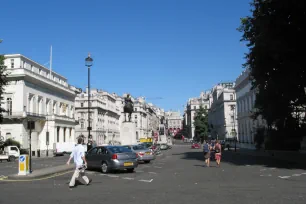
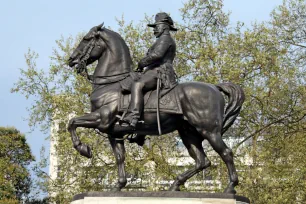
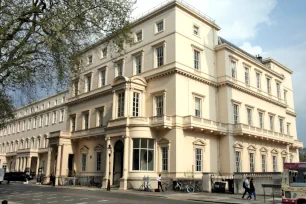
Waterloo Place was created at the end of the 1820s as the final piece of the triumphal way that connects Regent’s Park with Pall Mall. Construction of the triumphal way, which included Regent Street as its centerpiece, started in 1810 to a design by John Nash.
Carlton House, the residence of King George IV on Pall Mall, was a significant obstacle since the planned road ran straight through the mansion, but after the king died in 1830, Buckingham Palace became the main royal residence and Carlton House was demolished. In its place came two similar buildings, the Carlton House Terraces, with between them a monumental flight of steps that lead from Pall Mall towards a new open space that was named Waterloo Place in memory of the 1815 Battle of Waterloo, where Napoleon was defeated.
The Buildings
To the south, Waterloo Place is framed by the Carlton House Terraces, two massive buildings with Doric colonnades that overlook St. James’s Park. The two 140 meter long terraces were the last buildings designed by John Nash. The west terrace used to house the German embassy. It features an interior designed by Albert Speer, and outside is a small grave that commemorates Giro, the ambassador’s German shepherd who was accidentally electrocuted in 1934 when he chewed on electrical wires. His headstone, which reads ‘Ein treuer Begleiter’ (a faithful companion), is the only Nazi-era memorial in London.
The Doric theme is continued in the porticoes of the two majestic buildings that flank the middle of Waterloo Place. Both buildings were planned by Nash but eventually executed by Decimus Burton. The one on the northeast side is the Institute of Directors. Opposite is the Athenaeum, the most gracious of the two buildings, decorated with a long blue-and-white frieze that was inspired by the Parthenon. Above the portico stands a gilded statue of Pallas Athena.
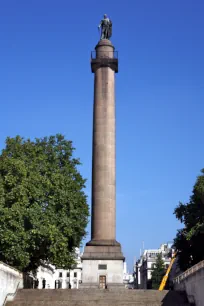
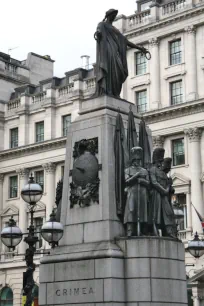
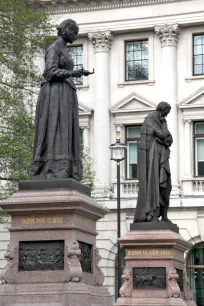
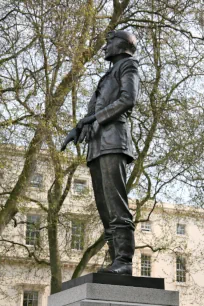
Statues and Monuments
Waterloo Place is adorned with an abundance of statues and monuments. The most eye-catching is undoubtedly the Duke of York Column, a 34-meter-tall (112 ft) granite column with a statue of Frederick, Duke of York and Albany. The monument was built in 1831-1834 to a design by Benjamin Dean Wyatt. The duke, who is best known for his reform of the army, is remembered in a nursery rhyme as the grand old duke who marched his men to the top of the hill, and marched them down again.
On the opposite, north side of Waterloo Place, in the middle of a traffic island, sits the Guards’ Crimean War Memorial, which commemorates the more than 2000 guards who died during the Crimean War of 1854-1856. The monument was designed by John Bell and installed here in 1860. It consists of a plinth topped with an allegorical statue of Honour. In front of the plinth stand guardsmen that were cast from melted down canons captured from the Russians.
Reporters of the war confronted the British citizens with the poor medical treatment of wounded soldiers, which prompted the Secretary of War, Sidney Herbert, to for the first time send female nurses to the front. One of these nurses was Florence Nightingale, who improved the conditions in the hospitals and saved the lives of numerous soldiers. She is honored with a statue in front of the Crimean War Memorial. She was known as the ‘Lady with the Lamp’, that’s why she is depicted holding a lamp in her hand. Next to her is a statue of Sidney Herbert, who facilitated Nightingale’s work.
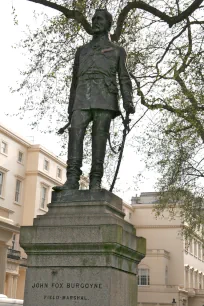
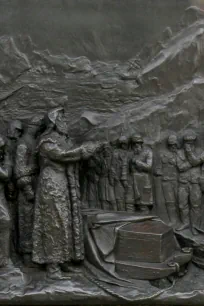
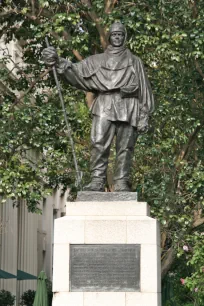
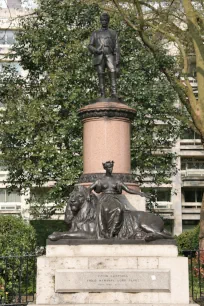
An equestrian statue in the middle of Waterloo Place honors King Edward VII. It was created in 1912-1921 by the Austrialian-born sculptor Bertram Mackennal after his original plans for a massive monument were rejected by George V, Edward VII’s successor.
Several more statues line Waterloo Place on the east and west side. The first statue on the west side, near Carlton House Terrace, is that of John Fox Burgoyne, who fought in the Iberian and Crimean Wars. His statue was created by Joseph Edgar Boehm and installed here in 1877.
Next to him is the statue of John Franklin, an arctic explorer known for his pursuit of finding a route through the Canadian Arctic Archipelago, the so-called Northwest passage. His last expedition never returned home. Search teams later found all 128 members of the expedition had died, and discovered evidence of extreme hardship and even cannibalism. Despite his failure, Franklin became a hero, hence his statue here. A relief on the pedestal depicts his burial in the Arctic. An inscription below states that he did find the Northwest passage he sacrificed his life for.
The following statue, near the Athenaeum, shows the New Zealander Keith Park, a flying ace during WWI. In WWII, he was responsible for the aerial defense of London during the Battle of Britain. The 2010 bronze statue, created by Les Johnson, shows Park readying himself for a flight.
Opposite is the statue of Robert Falcon Scott, an explorer who made two expeditions to Antarctica. In 1912, during the second expedition, he reached the South Pole, only to discover that Amundsen had beaten him to it. Scott and his four companions died on the return trip. The statue of Scott was created by his widow Kathleen Scott and depicts the explorer in a polar outfit.
Next to the statue of Scott is the largest monument on Waterloo Place, dedicated to Colin Campbell. Campbell was a British Army officer who fought in the Peninsula War, the War of 1812, the Opium War, the Anglo-Sikh War and the Crimean War, but he is most famous for his role during the Indian Mutiny, when he succeeded in raising the siege at Lucknow in 1857. Ten years later his statue, created by Carlo Marochetti, was unveiled here in Waterloo Place. In front of the granite plinth, on a couchant lion, sits the bronze figure of Brittania.
The next statue, near Carlton House Terrace, depicts John Lawrence, who also played a major role during the Indian Mutiny. In 1864, six years after the suppression of the rebellion, Lawrence became Viceroy of India. His statue was created by Joseph Edgar Boehm and erected here in 1882.

